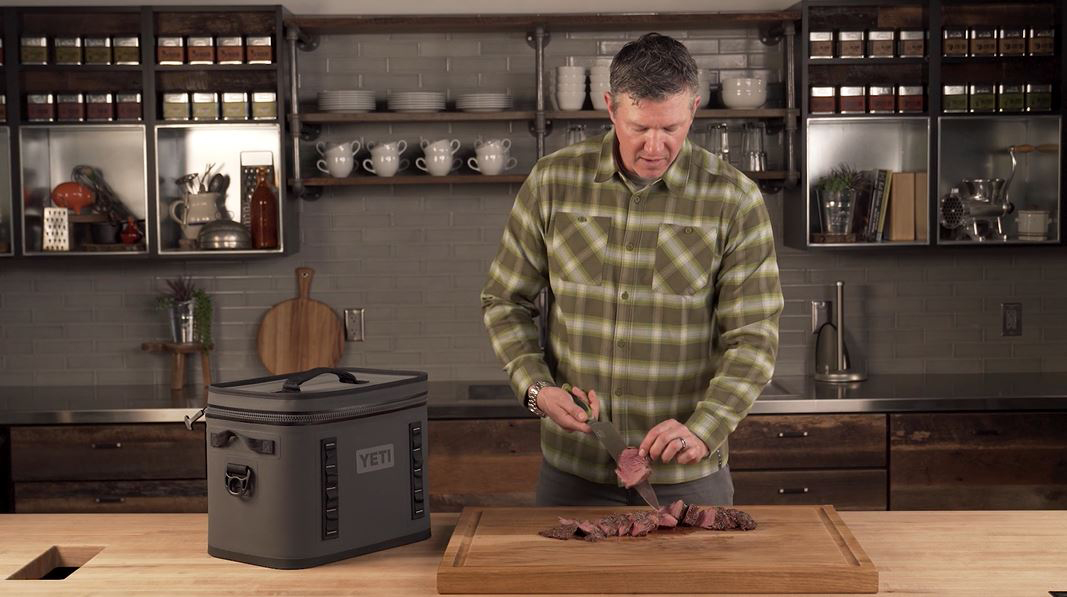When it comes to premium wild game cuts, few can rival the elk tenderloin. This incredibly tender piece deserves special treatment, and after years of refining my approach, I’ve found that the Traeger delivers unmatched results every time.
The key to cooking elk tenderloin lies in understanding this cut’s delicate nature and respecting its lean profile throughout the preparation process. Follow along as I walk you through my tried-and-true method for creating a mouthwatering elk tenderloin recipe that will impress even the most discerning wild game enthusiasts.
How to Prepare Elk Tenderloin: Less Is More
The elk tenderloin represents one of the most valuable cuts from your harvest, so proper preparation is crucial. Unlike tougher cuts that require aggressive trimming, the tenderloin demands a much lighter touch.
When working with your elk tenderloin, focus on minimal trimming:
- Remove the silver skin (thin, translucent membrane) using a sharp boning knife
- Lift the membrane gently and slice it away without removing excessive meat
- Trim away minimal fat, as wild elk is already exceptionally lean
- Remember that precision matters more than perfection with this premium cut
When handling elk tenderloins, I always remind myself that this is a super delicate piece of meat. Unlike beef tenderloin that often requires substantial fat removal, your elk tenderloin will have minimal fat to begin with. This leanness is part of what makes it so special – and what requires us to be especially careful not to overcook it later.
Best Elk Tenderloin Marinade: Building Flavor Foundations
What really elevates wild game tenderloin is an overnight marinade that infuses flavor without overwhelming the natural qualities of the meat.
Essential Marinade Ingredients:
- Dry red wine: Provides acidity and rich undertones
- Olive oil: Helps carry flavors and promotes even cooking
- Red wine vinegar: Adds brightness and tenderizing properties
- Soy sauce: Delivers savory depth and enhances browning
- Fresh garlic cloves: Infuses aromatic complexity
- Fresh rosemary: Contributes earthy, piney notes that pair perfectly with elk
- Salt and pepper: Enhances all other flavors
Combine these ingredients in a mixing bowl, whisking thoroughly to integrate everything. The beauty of this elk marinade is that precise measurements aren’t critical – you’re looking for balanced flavors that will complement the meat without dominating it.
Marinating Process:
- Place the elk tenderloin and marinade into a zip-top bag
- Add larger rosemary stalks to enhance the herbal infusion
- Squeeze out excess air before sealing the bag for maximum contact between marinade and meat
- Lay the bag flat in your refrigerator and flip occasionally throughout the marinating period
- Allow to marinate for at least 8 hours, preferably overnight
Traeger Elk Tenderloin Preparation: Setting the Stage for Success
After marinating overnight, it’s time to prepare for the Traeger. This grilled elk tenderloin method delivers consistent results that showcase the meat’s quality.
Traeger Setup:
- Preheat your Traeger grill to 450°F for a proper sear
- Use apple wood pellets for subtle sweetness that complements elk tenderloin
- Remove the tenderloin from the marinade and pat partially dry with paper towels
- Season generously with salt and pepper to create a flavorful crust
The final seasoning layer creates a flavorful crust that seals in juices while providing textural contrast to the tender interior. Don’t be shy here – a proper crust requires adequate seasoning to enhance your Traeger elk tenderloin.
Cooking Elk Tenderloin to Perfection: Timing Is Everything
With wild game, especially lean cuts like elk tenderloin, proper cooking temperature is absolutely critical. Overcooking will quickly transform this premium cut into a disappointment.
Step-by-Step Cooking Process:
- Place the seasoned elk tenderloin directly on the preheated grill grates
- Insert the temperature probe into the thickest part of the meat
- Close the lid and monitor the temperature closely (this will be a quick cook)
- When the internal temperature reaches about 100°F, flip the tenderloin for even searing
- Continue cooking until you reach your target temperature:
- 125-130°F for rare
- 130-135°F for perfect medium-rare (recommended for elk tenderloin)
- 135-140°F for medium (maximum recommended)
The Traeger’s WiFIRE app is invaluable for cooking elk tenderloin, allowing you to monitor the temperature progression without constantly opening the lid and losing heat.
The Secret to Perfect Elk Tenderloin: The Essential Rest
Once your elk tenderloin reaches the target temperature (130-132°F for that perfect medium-rare), remove it from the grill. But here’s where many hunters make a critical mistake – rushing to slice into that beautiful piece of meat.
The Resting Process:
- Wrap the elk tenderloin tightly in aluminum foil
- Place it in an insulated cooler (like a Yeti) for about 20 minutes
- Allow the internal juices to redistribute throughout the meat
- Let the temperature equalize from edge to center
“One of the keys to making your wild game cuts better is resting those pieces in a cooler,” I always tell fellow hunters. “This allows all of the internal juices to redistribute throughout that cut. And it really does balance out the entire cut of meat.”
This resting technique is essential for achieving the full potential of your elk tenderloin recipe.
Serving Your Traeger Elk Tenderloin: The Moment of Truth
After resting, unwrap your elk tenderloin on a cutting board. You’ll notice it’s still warm but not steaming hot – perfect for serving.
Perfect Slicing Technique:
- Slice the tenderloin on a slight diagonal, creating pieces about half an inch thick
- This angled cut creates broader slices with optimal texture
- Look for perfectly pink, juicy meat from edge to edge
- Serve immediately to experience the full flavor of your grilled elk tenderloin
The consistency throughout the entire elk tenderloin is what separates a properly handled cut from an amateur attempt. When done correctly, there should be no gradient from overcooked exterior to rare center – just beautiful, even doneness throughout.
Why This Elk Tenderloin Recipe Works: Wild Game Worth Celebrating
This Traeger elk tenderloin recipe represents wild game cooking at its finest – respecting the resource through proper preparation while enhancing its natural qualities. The combination of overnight marination, precise Traeger grilling, and that critical rest period transforms an already special cut into something truly exceptional.
When you bite into that first slice of perfectly cooked elk tenderloin, you’ll experience the ideal balance of savory crust and tender, juicy center. The flavor is distinct yet refined, with just enough seasoning to complement rather than mask the natural qualities of the meat.
For hunters who work hard to fill their freezers, techniques like these ensure we’re honoring that harvest by preparing it with the care it deserves. Whether you’re cooking for fellow hunters or introducing someone to wild game for the first time, this elk tenderloin recipe delivers results worth savoring.
Quick Reference Guide: Elk Tenderloin on the Traeger
- Prep Time: 20 minutes (plus overnight marinating)
- Cook Time: 20-25 minutes
- Rest Time: 20 minutes
- Total Time: 1 hour (plus marinating)
- Ideal Internal Temperature: 130-132°F (medium-rare)
- Wood Pellet Recommendation: Apple or cherry
- Servings: 4-6 depending on tenderloin size





 massmonopoly
massmonopoly